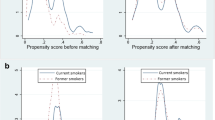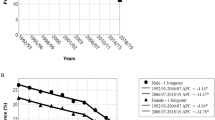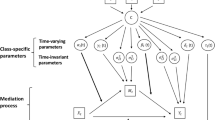Abstract
We compared two stage-of-change models that differentiate smokers by their level in the quitting process. The original 1983 model by Prochaska and DiClemente (1) divided smokers first by relapse status and then by intention to quit; their revised 1991 model (2) reversed the primacy of these factors. No published data justify whether the revision improves prediction of cessation. We used data from a population-based panel of 1,921 smokers interviewed in 1990 and 1992 for the California Tobacco Surveys. Model variables (quitting intention and recent quitting history) were used in a logistic regression to predict 30-day or longer cessation at follow-up and quit attempts made during the year preceding the survey. Predictive power of the revised model was not better than predictive power of the original model. New approaches to differentiating smokers on likelihood to quit should emphasize quitting behavior rather than intention to quit.
Similar content being viewed by others
References
Prochaska JO, DiClemente CC: Stages and processes of self-change in smoking: Toward an integrative model of change.Journal of Consulting and Clinical Psychology. 1983,51:390–395.
DiClemente CC, Prochaska JO, Fairhurst SK, et al: The process of smoking cessation: An analysis of precontemplation, contemplation, and preparation stages of change.Journal of Consulting and Clinical Psychology. 1991,59:295–304.
Prochaska JO, DiClemente CC:The Transtheoretical Approach: Crossing the Traditional Boundaries of Therapy. Homewood, IL: Dow-Jones/Irwin, 1984.
Prochaska JO, DiClemente CC: Common processes of self-change in smoking, weight control, and psychological distress. In Sniff-man S, Wills TA(eds),Coping and Substance Use. San Diego, CA: Academic Press, 1985, 345–363.
Prochaska JO, DiClemente CC: Toward a comprehensive model of change. In Miller WR, Heather N (eds),Treating Addictive Behaviors: Processes of Change. New York: Plenum Press, 1986, 3–27.
Prochaska JO, DiClemente CC: Stages of change in the modification of problem behaviors. In Hersen M, Eisler RM, Miller PM (eds),Progress in Behavior Modification. Newbury Park, CA: Sage, 1992, 184–218.
Prochaska JO:Systems of Psychotherapy: A Transtheoretical Analysis (2nd Ed.). Homewood, IL: Dorsey Press, 1984.
Prochaska JO, Rossi JS, Wilcox NS: Change processes and psychotherapy outcome in integrative case research.Journal of Psychotherapy Integration. 1991,7:103–120.
Gottlieb HH, Galavotti C, McCuan RS, et al: Specification of a social cognitive model predicting smoking cessation in a Mexican-American population: A prospective study.Cognitive Therapy and Research. 1991,14:529–542.
Janis IL, Mann L:Decision-Making: A Psychological Analysis of Conflict, Choice, and Commitment. London: Cassel & Collier MacMillan, 1977.
Velicer WF, DiClemente CC, Prochaska JO, et al: A decisional balance measure for predicting smoking cessation.Journal of Personality and Social Psychology. 1985,48:1279–1289.
Prochaska JO, DiClemente CC, Velicer WF, et al: Predicting change in smoking status for self-changers.Addictive Behaviors. 1985,10:395–406.
Bandura A: Self-efficacy: Toward a unifying theory of behavior change.Psychological Review. 1977,84:191–215.
Bandura A: Self-efficacy mechanism in human agency.American Psychologist. 1982,37:122–147.
DiClemente CC: Self-efficacy and the addictive behaviors.Journal of Social and Clinical Psychology. 1986,4:302–315.
DiClemente CC, Prochaska JO, Gibertini M: Self-efficacy and the stages of self-change of smoking.Cognitive Therapy and Research. 1985,9:181–200.
Velicer WF, DiClemente CC, Rossi JS, et al: Relapse situations and self-efficacy: An integrative model.Addictive Behaviors. 1990,75:271–283.
Prochaska JO, Velicer WF, Guadahnoli E, et al: Patterns of change: Dynamic typology applied to smoking cessation.Multivariate Behavioral Research. 1991,26:83–107.
Prochaska JO, Velicer WF, Rossi JS, et al: Stages of change and decisional balance for 12 problem behaviors.Health Psychology. 1994,13:39–46.
Prochaska JO, Goldstein MG: Process of smoking cessation: Implications for clinicians.Clinics in Chest Medicine. 1985,12:121–735.
Prochaska JO, DiClemente CC, Velicer WF, et al: Standardized, individualized, interactive, and personalized self-help programs for smoking cessation.Health Psychology. 1993,12:399–405.
Velicer WF, Prochaska JO, Rossi JS, et al: Assessing outcome in smoking cessation studies.Psychological Bulletin. 1992,111:23–41.
Wilcox NS, Prochaska JO, Velicer WF, et al: Subject characteristics as predictors of self-change in smoking.Addictive Behaviors. 1985,10:407–412.
Prochaska JO, DiClemente CC, Velicer WF, et al: Comments on Davidson’s “Prochaska and DiClemente’s model of change: A case study?”British Journal of Addiction. 1992,87:825–828.
Kaplan RM, Pierce JP, Gilpin EA, et al: Stages of smoking cessation: The 1990 Tobacco Survey.Tobacco Control. 1993,2:139–144.
Waksberg J: Sampling methods for random-digit dialing.Journal of the American Statistical Association. 1978,73:40–46.
Pierce JP, Farkas A, Evans N, et al:Tobacco Use in California 1992. A Focus on Preventing Uptake in Adolescents. Sacramento, CA: California Department of Health Services, 1993.
Borland R, Pierce JE Burns DM, et al: Protection from environmental tobacco smoke in California: The case for a smoke-free workplace.Journal of the American Medical Association. 1992,268:749–752.
Pierce JP, Goodman J, Gilpin EA, Berry C:Technical Report on Analytic Methods and Approaches Used in the Tobacco Use in California, 1990–1991 Report. Sacramento, CA: California Department of Health Services, 1992.
Pierce JE, Cavin SW, Macky C, et al:Technical Report on Analytic Methods and Approaches Used in the 1993 California Tobacco Survey Analysis. Sacramento, CA: California Department of Health Services, 1994.
Efron B: The jackknife, the bootstrap, and other resampling plans.CBMS Regional Conference Series in Applied Mathematics, 38. Philadelphia, PA: Society for Industrial and Applied Mathematics, 1982.
Rao JKN, Scott A J: The analysis of categorical data from complex sample surveys: Chi-squared tests for goodness of fit and independence in two-way tables.Journal of the American Statistical Association. 1985,76:221–230.
Rao JKN, Scott AJ: On chi-square tests for multiway contingency tables with cell proportions estimated from survey data.Archives of Statistics. 1984,12:46–60.
Metz CE: Basic principles of ROC analysis.Seminars in Nuclear Medicine. 1978,8:283–298.
Hanley JA, McNeil BJ: The meaning and use of the area under a receiver-operating-characteristic (ROC) curve.Radiology. 1982,143:29–36.
Brainerd CJ: The stage question in cognitive-developmental theory.The Behavioral and Brain Sciences. 1978,1:173–213.
Zimbardo PG, Ruch FL:Essentials of Psychology and Life (10th Ed.). Glenview, IL: Scott, Foresman and Company, 1980.
Bandura A:Social Foundations of Thought and Action. A Social Cognitive Theory. Englewood Cliffs, NJ: Prentice-Hall, Inc., 1986.
Gilpin EA, Pierce JP, Cavin SW, et al: Estimates of population smoking prevalence: Self- vs. proxy reports of smoking status.American Journal of Public Health. 1994,84:1576–1579.
Gilpin EA, Pierce JP: Measuring smoking cessation: Problems with recall in the 1990 California Tobacco Survey.Cancer Epidemiology, Biomarkers and Prevention. 1994,3:613–617.
Biener L, Abrams DB: The contemplation ladder: Validation of a measure of readiness to consider smoking cessation.Health Psychology. 1991,10:360–365.
Abrams DB, Biener L: Motivational characteristics of smokers in the workplace: A public health challenge.Preventive Medicine. 1992,21:679–687.
Author information
Authors and Affiliations
Additional information
Data collection for this study was supported by contract 92-16010 from the California Department of Health Services, Tobacco Control Section, Sacramento. Data analyses were funded by the Robert Wood Johnson Foundation. This work was done during Dr. Pierce’s established investigatorship from the American Heart Association.
About this article
Cite this article
Farkas, A.J., Pierce, J.P., Gilpin, E.A. et al. Is stage-of-change a useful measure of the likelihood of smoking cessation?. Ann Behav Med 18, 79–86 (1996). https://doi.org/10.1007/BF02909579
Issue Date:
DOI: https://doi.org/10.1007/BF02909579




